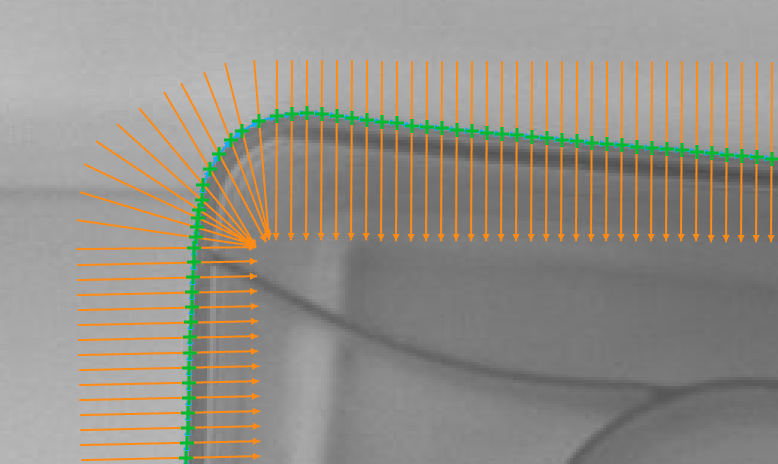You are here: Start » AVL.NET » Function Reference » Computer Vision » Shape Fitting » AVL.FitPathToEdges
Performs a series of 1D edge detections and creates a path from the detected points.
| Namespace: | AvlNet |
|---|---|
| Assembly: | AVL.NET.dll |
Syntax
public static void FitPathToEdges ( AvlNet.Image inImage, AvlNet.PathFittingMap inFittingMap, AvlNet.EdgeScanParams inEdgeScanParams, AvlNet.Selection inEdgeSelection, AvlNet.LocalBlindness? inLocalBlindness, int? inMaxInterpolationLength, float? inMaxDeviationDelta, float inMaxIncompleteness, INullable<AvlNet.Path> outPath, NullableRef<List<AvlNet.Edge1D?>> outEdges, NullableRef<NullableRef<AvlNet.Profile>> outDeviationProfile, IList<AvlNet.Profile> diagBrightnessProfiles, IList<AvlNet.Profile> diagResponseProfiles )
Parameters
| Name | Type | Range | Default | Description | |
|---|---|---|---|---|---|
 | inImage | AvlNet.Image | Image to fit the path to. | ||
 | inFittingMap | AvlNet.PathFittingMap | Input fitting map. | ||
 | inEdgeScanParams | AvlNet.EdgeScanParams | Parameters controlling the edge extraction process. | ||
 | inEdgeSelection | AvlNet.Selection | avl::Selection::Best | Selection mode of edges. Default value: avl::Selection::Best. | |
 | inLocalBlindness | AvlNet.LocalBlindness? | Defines conditions in which weaker edges can be detected in the vicinity of stronger edges. Default value: atl::NIL. | ||
 | inMaxInterpolationLength | int? | <0, INF> | Maximal number of consecutive points not found. Default value: atl::NIL. | |
 | inMaxDeviationDelta | float? | <0.0f, INF> | Maximal difference between deviations of consecutive path points. Default value: atl::NIL. | |
 | inMaxIncompleteness | float | <0.0f, 0.999f> | 0.1f | Maximal fraction of edge points not found. Default value: 0.1f. |
 | outPath | AvlNet.INullable<AvlNet.Path> | Fitted path or nothing if the fitting failed. This parameter cannot be null. | ||
 | outEdges | AvlNet.NullableRef<System.Collections.Generic.List<AvlNet.Edge1D?>> | Found edges. Can be null to skip this parameter calculation. | ||
 | outDeviationProfile | AvlNet.NullableRef<AvlNet.NullableRef<AvlNet.Profile>> | Profile of distances between the actual path points and the corresponding reference path points. Can be null to skip this parameter calculation. | ||
 | diagBrightnessProfiles | System.Collections.Generic.IList<AvlNet.Profile> | Extracted image profiles. | ||
 | diagResponseProfiles | System.Collections.Generic.IList<AvlNet.Profile> | Profiles of the edge (derivative) operator response. |
Description
The operation tries to fit a given path to edges present in the inImage image. Internally, it performs a series of scans with the ScanSingleEdge filter using inFittingMap previously generated from the object being fitted. The found points are then used to determine the actual position of the path in the image. Only inMaxIncompleteness fraction of these scans may fail. If the fitting according to the given parameters is not possible, outPath is set to Nil.
There are also another parameters that control the path fitting process. The inMaxDeviationDelta parameter defines the maximal allowed difference between deviations of consecutive points from the input path points. If some of the scans fail or if some of found points are classified to be wrong according to another control parameters, output path points corresponding to them are interpolated depending on points in their nearest vicinity. No more than inMaxInterpolationLength consecutive points can be interpolated. The exception to this behavior are points which were not found on both ends of the input path. Those are not part of the result at all.
Examples

Fitting a path to the edges of a plastic capsule
(inEdgeSelection = First, inEdgeScanParams.EdgeTransition = BrightToDark).
Remarks
Read more about Local Coordinate Systems in Machine Vision Guide: Local Coordinate Systems.
This filter is a part of the Shape Fitting toolset. To read more about this technique, one can refer to the Shape Fitting chapter of our Machine Vision Guide
Hardware Acceleration
This operation supports automatic parallelization for multicore and multiprocessor systems.
Hardware acceleration settings may be manipulated with Settings class.
Function Overrides
- FitPathToEdges(Image, PathFittingMap, EdgeScanParams, Selection, Single, INullable<Path>)
- FitPathToEdges(Image, PathFittingMap, EdgeScanParams, Selection, Nullable<LocalBlindness>, Nullable<Int32>, Nullable<Single>, Single, INullable<Path>)
- FitPathToEdges(Image, PathFittingMap, EdgeScanParams, Selection, Nullable<LocalBlindness>, Nullable<Int32>, Nullable<Single>, Single, INullable<Path>, NullableRef<List<Nullable<Edge1D>>>, NullableRef<NullableRef<Profile>>)
- FitPathToEdges(Image, PathFittingMap, EdgeScanParams, Selection, Nullable<LocalBlindness>, Nullable<Int32>, Nullable<Single>, Single, INullable<Path>, IList<Nullable<Edge1D>>, INullable<Profile>, IList<Profile>, IList<Profile>)

